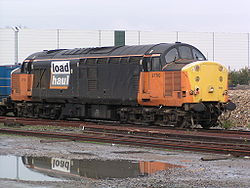British Rail Class 37
The British Rail Class 37 is a diesel-electric locomotive. It is also known as the English Electric Type 3. The Class was ordered as part of the British Rail modernisation plan.
| English Electric Type 3 British Rail Class 37 | |

| |
| Class 37 in British Rail large logo livery at Muir of Ord railway station, 1988 | |
| Power type | Diesel-electric |
|---|---|
| Builder | English Electric at Vulcan Foundry and Robert Stephenson and Hawthorns |
| Build date | 1960–1965 |
| Total production | 309 |
| Configuration | Co-Co |
| UIC classification | Co'Co' |
| Gauge | Lua error in package.lua at line 80: module 'Module:Track gauge/data' not found. |
| Wheel diameter | 3 ft 9 in (1.143 m) |
| Minimum curve | 4 chains (80 m) |
| Wheelbase | 50 ft 8 in (15.44 m) |
| Length | 61 ft 6 in (18.75 m) |
| Width | 8 ft 10+1⁄2 in (2.71 m) |
| Height | 12 ft 9 in (3.89 m) |
| Locomotive weight | 100 long tons (102 t) to 105 long tons (107 t) except 37/7 and 37/9 class - ballasted to 120 tonnes[1] |
| Fuel capacity | 890 imp gal (4,000 L; 1,070 US gal) increased to 1,690 imp gal (7,700 L; 2,030 US gal) on rebuild[1] |
| Prime mover | Built: English Electric 12CSVT 37/9: Mirrlees Blackstone MB275Tt or Ruston RK270Tt |
| Generator | Original: Main: English Electric EE822, Aux EE911/5C Rebuilt locos: Main: Brush BA1005A alternator, Aux: Brush BA606A [1] |
| Traction motors | English Electric [1] |
| Transmission | electrical (DC traction motors) |
| Multiple working | ★ Blue Star |
| Top speed | 90 mph (140 km/h) |
| Power output | Engine: 1,750 bhp (1,305 kW) |
| Tractive effort | Maximum: 55,500 lbf (247 kN) Continuous: 35,000 lbf (156 kN) @13.6 mph (22 km/h)[2] |
| Train heating | 37/0: Steam generator 37/4: Electric Train Heat Remainder: None |
| Locomotive brakeforce | 50 long tons-force (498 kN) |
| Train brakes | Vacuum, Dual, or Air |
| Career | British Rail DB Schenker DRS West Coast Railway Company |
| Number | D6700–D6999, D6600–D6608; later 37001–37308 |
| Nicknames | Tractor, also Syphon, Growler or Slugs[3] |
| Axle load class | Route availability 5 except subclass 37/7 RA 7 |
The Class 37 became a familiar sight on many parts of the British Rail network. They were on Inter-City services in East Anglia and within Scotland. They also performed well on secondary and inter-regional services for many years. The Class 37 is known by railway enthusiasts as a "Tractor". This nickname came from the similarity of the sound of the locomotive.
British Rail Class 37 Media
37891 with Mainline Freight branding at Eastleigh, 1995
37263 at Didcot
37371 at Eastleigh
BR Class 37/4 37409 Loch Awe at Fort William in 1989
Two Eurostar 37/6 types at Clapham Junction
Loadhaul liveried 37/7 type
References
- ↑ 1.0 1.1 1.2 1.3 "The Railway Centre - Class 37". Archived from the original on 2013-09-26. Retrieved 2010-03-29.
- ↑ "Locomotive Database - BR Class 37 Technical Data". auran.com. 2012. Retrieved 24 July 2012.
- ↑ "Locomotive, DMU and EMU Nicknames". Archived from the original on 2010-01-30. Retrieved 2010-03-29.









